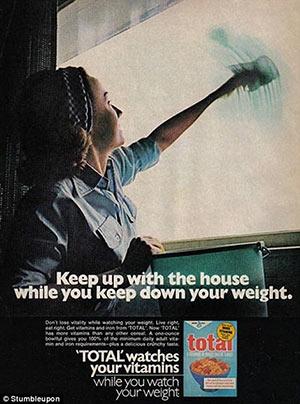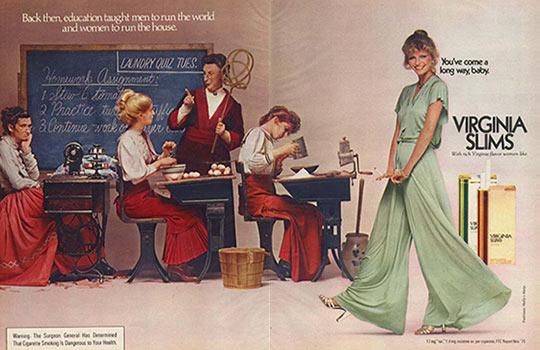As marketers, we have some responsibility for what “normal” looks like.
Here’s a playful example from history.

Hoo boy.
Crappy, yes, but also not too far from the
reality of many women’s lives at the time. And when the women’s movement of the 60s and 70s started to challenge how women were expected to behave, elements of the advertising industry
started to follow suit. Clumsily, inconsistently, and much too slowly, but followed suit nonetheless.

Today, it’s easy to be uncharitable to these early progressive ads
(most of them just swapped one type of pandering for another: “you’re a good little feminist, aren’t you!”, but back then they actually did some good, and in a mostly
unintended way: they put single, working women onscreen and in print again and again, and over time normalized the sight. Happy divorced women. Happy childless women. Happy women with white collar
jobs. For most Americans — who had no access to the academic and intellectual venues where women’s lib was getting hashed out — these ads were the vanguard of what real life was
about to look like.
advertisement
advertisement
(I know: a criminally oversimplified history. But bear with me.)
Ok, enough stalling for time. I’ll confine my remarks about our
President-elect, his campaign, and his supporters to a few objective observations. Multiple polls indicate that Trump’s base has a problem with sexism and racism. Some of his senior advisors do too — including an Attorney General nominee who once called a white civil rights lawyer “a disgrace to his race.”
Hoo boy.
You may not conclude that the
triumph of Trump is a triumph of racism, but what cannot be disputed is this: putting enablers of white supremacy in senior White House positions empowers people, symbolically if not literally, who
actively harbor white supremacist feelings. Period. Full stop.
People take their cues from the prevalent voices in the culture. The proof is in the approximately 900 “hate incidents” that have
been reported since the election alone.
In this climate, you could be forgiven for wondering whether this is what normal is going to look like now.
As marketers, we have the rare ability to say no.
Rare, because we get to do it in public,
unlike most Americans, and we also get to see it work.
What normal looks like is kind of our game. Not that what we’ve gone with has always been right (ahem), but maybe now’s a good
time to change that.
Correction: now is the crucial time to change that. You’ve all been told, at certain times, that your creative needed more diversity, but only when it made
sense for the brand and the intended audience. Only when it was a business decision.
Today? I don’t think it’s overstatement to call it a moral decision. After this
election, showing that the norm is diversity and acceptance, not xenophobia and paranoia: this is morality, not business. In a culture where undocumented Mexicans, Syrian refugees, and a gay couple
holding hands in public represent threats to American values, it’s simply no longer ok to continue treating white heterosexual families as the de facto characters of our work.
We have to show more mixed-race families. We have to show more African-American families of privilege, since the next president apparently thinks they all live in “inner cities”.
We have to stop forgetting about Asian-Americans. We have to keep chipping away at the deeply, deeply ingrained idea that women are either moms or sex objects. We have to embrace gay marriage and
equality for women without patting ourselves on the back for it. Equality is not a campaign value: it’s a way of life, and a right, and a moral imperative.
Some of you will say
“But [INSERT MINORITY GROUP] don’t buy [INSERT PRODUCT]!” Which seems like a chicken and egg thing to me — and I’m guessing, in your private moments, it does to you too.
Let’s see what happens if we commit some real resources.
Others will say “But [INSERT DEMOGRAPHIC 1] will tune out if they see a [INSERT DEMOGRAPHIC 2] in the first three
seconds of the spot!” To which I say: WHY ARE WE OK WITH THIS KIND OF THINKING?
I’ll admit: to my ears this would have sounded like a lot of liberal navel-gazing a year
ago, but things have changed. We have to promote messages of inclusion and compassion, not because it’s better for the bottom line (it is), or because it puts us on the right side of history (it
does), but because, in 2017, it’s the right thing to do. Visibility protects people from prejudice, and it’s possible that a lot of people are about to need protecting — even in our
small, sometimes clumsy way.
Of course, as you’re all thinking: this sounds great, but it kinda depends on the clients. True enough — and also true that not every
campaign will be an opportunity to wage holy war on the patriarchy.
But that doesn’t mean the patriarchy isn’t real, or worth fighting whenever possible. We’re in
the business of creating opportunities. And it all starts — as it did in the 60s — with a simple resolution:
We’re ready to be brave. Are you?